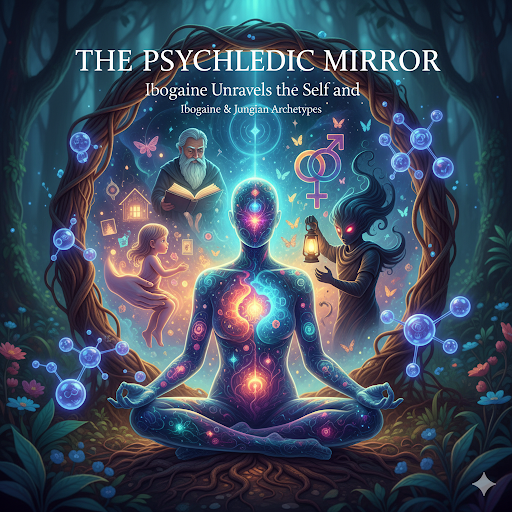The resurgence of ibogaine in medical and therapeutic discourse isn’t just about addiction interruption; it’s about a profound, introspective journey that can fundamentally rewire an individual’s psychological landscape. Beyond its neurochemical impact, ibogaine acts as a potent tool for accessing the deeper layers of the psyche, offering a unique opportunity to engage with Jungian archetypes and integrate fragmented aspects of the self. This guest post delves into how ibogaine facilitates the unraveling of the Child and Shadow archetypes, providing crucial insights into past traumas and unconscious motivations, and explores other archetypes that surface during this powerful experience.
Unraveling the Child Archetype: A Journey to Heal Childhood Trauma
For many, the core of their emotional struggles lies buried in childhood. The Child Archetype, as described by Carl Jung, represents our original, authentic self – our innocence, vulnerability, potential, and innate desires. When childhood is marked by trauma, neglect, or abuse, this archetype can become wounded, suppressed, or distorted, leading to enduring patterns of behavior, emotional dysregulation, and a pervasive sense of inadequacy in adulthood.
Ibogaine’s unique mechanism, particularly its protracted, dream-like visionary state, offers an unparalleled opportunity to revisit these foundational experiences. Unlike other psychedelics that might offer fleeting glimpses, ibogaine can facilitate an immersive, extended introspection where past memories, often long suppressed, resurface with vivid clarity.
During an ibogaine session, individuals frequently report experiencing:
- Regressive Visions: Many describe being transported back to specific moments of their childhood, not merely as an observer, but often as a participant re-experiencing emotions from that time. This is not simply a memory recall; it’s an emotional re-experiencing that allows the adult consciousness to witness the trauma from a detached, yet deeply empathetic perspective.
- Dialogue with the Inner Child: The visionary state can manifest the wounded Child Archetype as a distinct entity within the psyche. Individuals might find themselves able to comfort, validate, or even guide their younger selves through past painful events. This “dialogue” is a powerful act of re-parenting, where the conscious adult provides the care and understanding that was missing during the original trauma.
- Identification of Core Wounds: By revisiting these moments, the individual gains profound insight into the origins of their adult patterns. A person struggling with codependency might see how early experiences of needing to please a volatile parent shaped their adult relationships. Someone with chronic anxiety might trace it back to a sustained period of perceived threat in childhood. Ibogaine helps to “connect the dots” between past wounds and present struggles, illuminating the genesis of unhealthy coping mechanisms.
- Reclaiming Lost Innocence and Joy: Beyond confronting trauma, the journey into the Child Archetype can also reveal moments of forgotten joy, creativity, and authenticity. This allows for the integration of the healthy aspects of the Child – playfulness, wonder, and uninhibited self-expression – which may have been suppressed in the wake of trauma.
The therapeutic benefit lies in this ability to consciously process and integrate these early experiences. It’s not about reliving the pain to be stuck there, but to “unravel” the impact, understand its imprint, and consciously choose a new narrative for the self, thereby releasing the grip of past trauma.
Unraveling the Shadow: Gaining Insight into Unconscious Motivations
Jung’s Shadow Archetype represents the repressed, unacknowledged, and often negative aspects of our personality. These are the parts of ourselves we deem unacceptable, hide from others, and often from ourselves – anger, jealousy, selfishness, shame, but also raw power, creativity, and instinct. The Shadow often manifests as “acting out of character” – moments of irrational rage, destructive self-sabotage, or inexplicable emotional outbursts.
Ibogaine’s deep dive into the subconscious is particularly effective at bringing the Shadow into conscious awareness. The visionary experience can strip away ego defenses, revealing hidden motivations and patterns that drive seemingly inexplicable behaviors.
- Confronting Unacknowledged Impulses: Individuals might witness themselves engaging in behaviors they find shameful or recognize destructive patterns in their relationships or career. The visionary state can present these “shadow behaviors” in a stark, undeniable manner, forcing conscious recognition.
- Understanding “Out of Character” Moments: Ibogaine can illuminate the underlying emotional triggers and historical contexts for moments where a person “acted out of character.” For example, someone who prides themselves on being calm might, under ibogaine, see a recurring pattern of aggressive outbursts when feeling controlled, tracing this back to a dynamic with an overbearing authority figure in their past. The insight gained is not just what they did, but why the Shadow took over.
- Integrating Repressed Aspects: The goal is not to eliminate the Shadow, but to integrate it. Ibogaine facilitates the understanding that these “dark” aspects are often misunderstood or misdirected energies. A person who constantly avoids conflict might see their repressed anger as a powerful, protective force that, if acknowledged and channeled appropriately, could allow them to set healthy boundaries.
- Reclaiming Personal Power: By recognizing and integrating the Shadow, individuals reclaim the energy and insight previously expended on repression. This leads to a more holistic sense of self, reducing internal conflict and enabling more authentic, self-aware choices in life. It’s about consciously choosing how to engage with these powerful aspects rather than being unconsciously driven by them.
Other Archetypes Relative to the Introspective Ibogaine Experience
While the Child and Shadow are frequently encountered, ibogaine’s profound introspection can activate or bring into focus other significant archetypes:
- The Hero Archetype: This archetype often manifests as the individual’s journey through the ibogaine experience itself – facing fears, confronting personal demons, and emerging transformed. The “hero’s journey” narrative is a common framework for understanding the challenging yet ultimately rewarding nature of the ibogaine process. It’s about developing courage, resilience, and personal conviction.
- The Sage/Mentor Archetype: During the visionary state, individuals sometimes encounter figures (or receive insights) that feel like ancient wisdom or guidance. This can manifest as an inner voice, a symbolic elder, or a sudden, profound understanding of universal truths. This archetype provides perspective, wisdom, and a sense of cosmic interconnectedness, often helping the individual integrate difficult insights.
- The Trickster Archetype: The Trickster often appears as chaos, paradox, or humorous absurdity, challenging rigid beliefs and assumptions. In the context of ibogaine, the Trickster can disrupt a person’s carefully constructed ego identity, forcing them to question their narrative and embrace uncertainty, ultimately leading to greater flexibility and adaptability. It can also manifest as strange or unsettling visions that serve to break down mental barriers.
- The Anima/Animus Archetype: These represent the unconscious feminine qualities in men (Anima) and masculine qualities in women (Animus). Ibogaine can facilitate a deeper understanding and integration of these complementary energies within the self, leading to greater emotional balance, empathy, and a more complete sense of identity beyond gender stereotypes. For example, a man might connect with his nurturing or intuitive side
For more information visit www.ibogaineclinic.com





